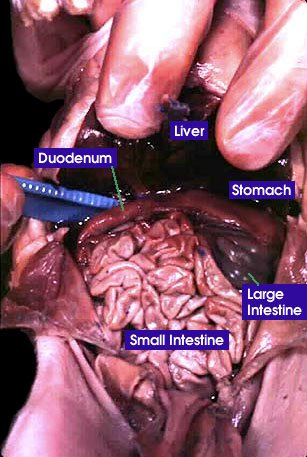Inside the Abdomen

In order to see the stomach, the two lobes of the liver must be lifted out of the way as shown here.
Small Intestine
Omnivores tend to have longer intestines than carnivores. The small intestine of a near-term fetal pig can be as long as 350 cm (~ 12 feet long) when separated from the mesentery (which holds and their blood vessels in a mass).
Within the various sections of the small intestine, digestion of food and absorption of nutrients occurs.
Large intestine
Far shorter than the small intestine, the large intestine (the colon is one region of it) is responsible for the absorption of water and vitamins and preparation of undigested materials as feces. The large intestine also houses large amounts of symbiotic bacteria.
Next: Gall bladder
Back to: Digestive system
Virtual Fetal Pig Dissection